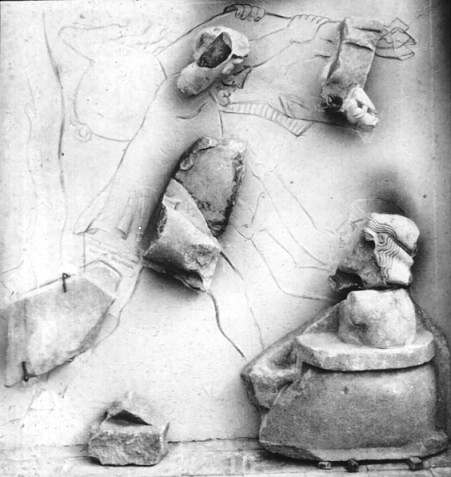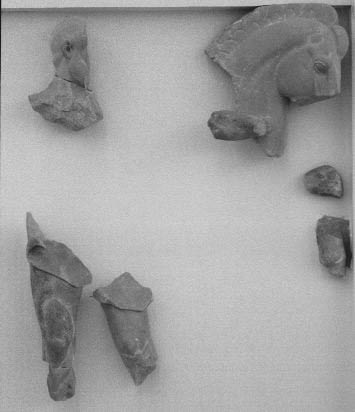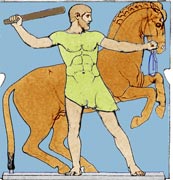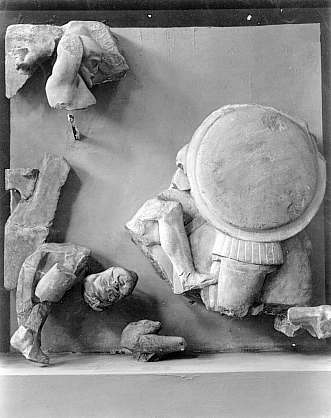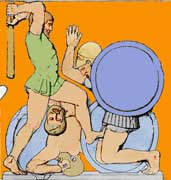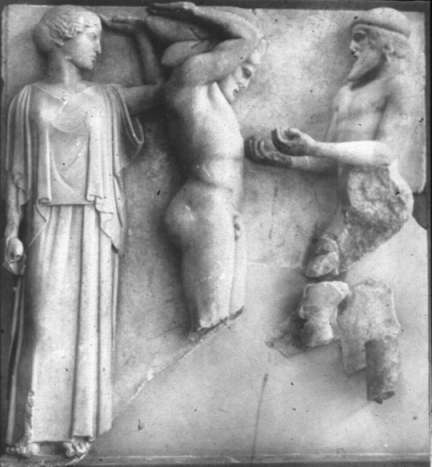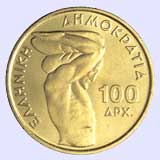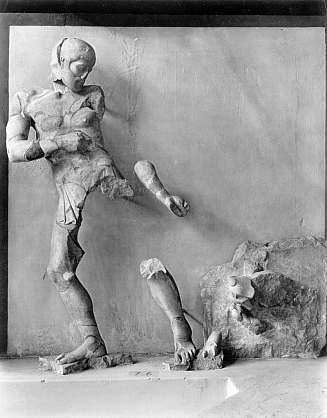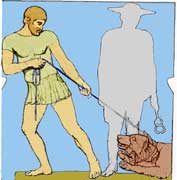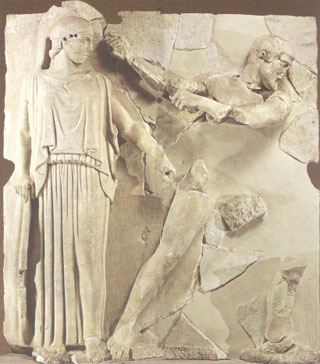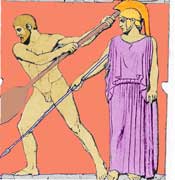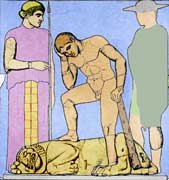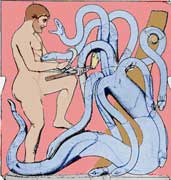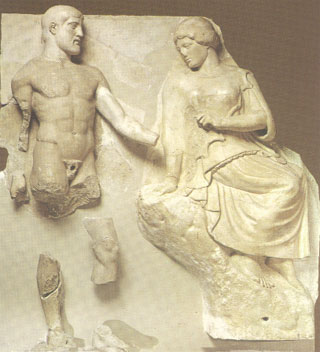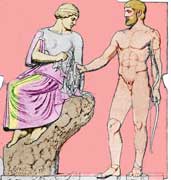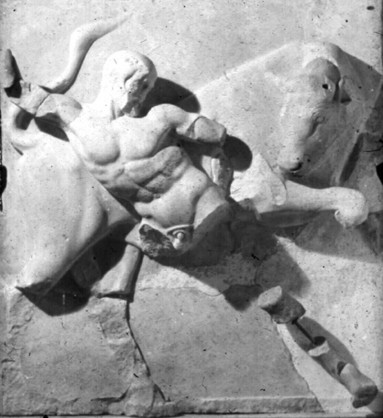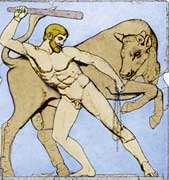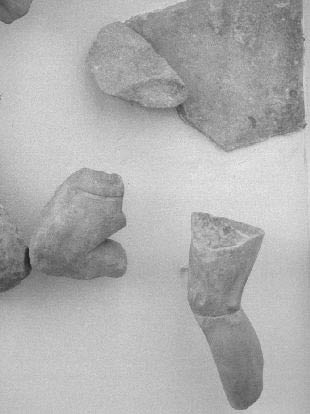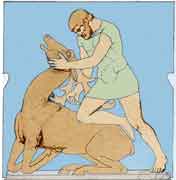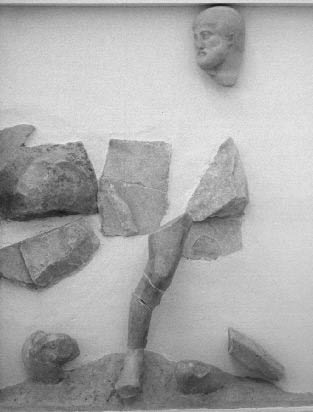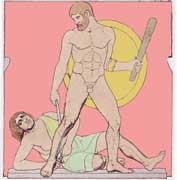.
Klassische Griechische Kunst
Also represented at Olympia are most of the Labours of Herakles. Above the doors of the temple is the hunt after the boar from Arcadia, and also Herakles’ exploits against Dionysos of Thrace and against Geryones in Erytheia; he is also shown as he is about to receive the burden from Atlas and against cleansing the earth of dung from the Eleans. .. Above the doors of the opisthodomos he is shown taking the Amazon’s girdle, and also represented there are his exploits against the stag, against the bull of Knossos, the birds at Stymphalos, the Hydra, and the lion in the territory of Argos. Pausanias
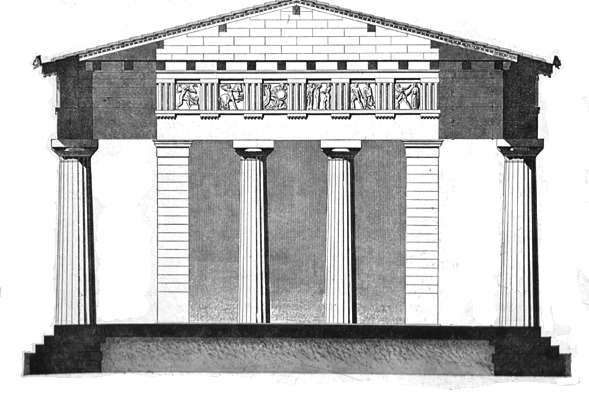
The Zeus Temple in Olympia, (a section) inside with the Metopes with the labors of Hercules
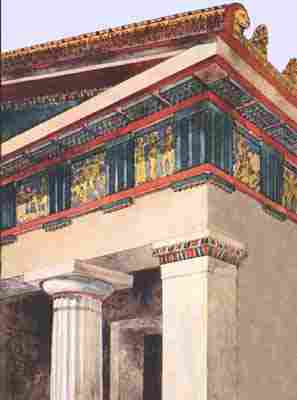
A Color Reconstruction of the temple according to Curtius and Adler
Temple of Zeus, Olympia (ca. 468-456 BC), Metope with the 12 labors of Heracles (Hercules). Hercules actually means glory of Hera from (Hera and kleos). This is strange because Hera did not like very much Hercules who was a child of her husband Zeus and the mortal woman Alcmene. The twelve sculptured metopes belong to a second frieze, placed above the columns and antae of pronaos and opisthodomos. Their subjects are the twelve labors of Heracles, beginning with the slaying of the Nemean lion and ending with the cleansing of the Augean stables.
Herakles is of as much importance at Olympia as Pelops. While the latter is shown as the founder of the Pelopid dynasty and represents the Mycenaean phase of the history of the sanctuary, Herakles is the mythical founder of the athletic contests in the Altis and is associated with the ancient cults which represent its Doric phase. It was therefore natural that the Labours of Herakles, which stirred every Greek, should form one of the temple's decorative themes. They, together with the chariot race of Pelops and Oinomaos and the Centauromachy, made up an expressive trilogy, an inspiration to those training at the sacred site of Olympia. On the western side is the Nemean Lion, the Lernaian Hydra, the Stynmphalian Birds, the Knossian Bull, the Kerynean Hind and the Girdle of the Amazons; on the eastern the Erymanthian Boar, the Mares of Diomedes, the Cattle of Geryons Atlas, Cerberus and the Cleansing of the Augean Stables. The designing of some of the scenes follows the ancient iconographic tradition. On the contrary, others bursting with a freshly-found strength, blaze new trails bearing the unstaled messages of the generation born after the Persian wars. In the first scene Herakles, as a young man, is not shown struggling with the lion as in the older tradition, but with the beast already dead. Exhausted, the first wrinkle creasing his brow, his head rests thoughtfully on his crooked right arm. Next to him, soft-eyed Athena keeps him company in the difficult task he has yet to accomplish. Such a depiction of the tired hero is unexpected, especially in this period overflowing with energy and with an unquenchable thirst for action. Its creator was far ahead of his time, for the underlying concept full of tragic pathos, was a precursor of much that was to come ; the theme of the tired hero is not found again for a hundred years, in the early Hellenistic period when the Greek world was indeed exhausted by the tribulations which beset it. Whereas the composition of the next metope, the slaying of the Lernaian Hydra, does not depart from the older models, a new spirit permeates the depiction of the Stymphalian Birds. Here, Athena, barefoot and though expecting flowers from her lover and not the dead birds, the fruit of Herakles' labours. This idyllic presentation supplants the older heroic content of the myth; a lyric quality has replaced the epic. Here, and in the metope depicting the slaying of the Nemean Lion, the dominance of the vertical and horizontal lines, and the total absence of motion reminds one of the composition of the eastern pediment. The same refreshing strength triumphs in the next of the Labours, the struggle of Herakles with the Knossian bull. But the oblique counter-balance of the powerful beast with the hero recalls the strongly dramatic figures locked in combat on the eastern pediment. In contrast the Keryneian Hind and the Amazons, the two last metopes on the western side, remain faithful to the older iconographical models. The same general characteristics can be seen in the metopes on the eastern side. Some are faithful copies of older models (the Erymanthian Boar, Geryones). Others are tinged with the awakening of the spirit of things yet to come, some akin to the characteristic of the eastern pediment, others with affinity to the western pediment. Although very fragmentary, the harmony and balance between vertical and horizontal lines of horse and hero are clear in the metope depicting Herakles and the Mares of Diomedes, just as it is in the figures of the western pediment. The same is true of the willowy figures in the metope of Atlas. Here Herakles, even though he is the greatest of the heroes, is only just able to support the weight of the sky, while the goddess has only to raise her left hand to relieve his burden. The difference between divinity and mortal is expressed simply, without rhetorical flourishes. But another aspect of the presentation of the myth is worth observing. While in older versions Atlas cast about for some ruse to leave Herakles supporting the weight of the sky forever, now he willingly offers him the apples. The attempt to rid the tale of any trace of trickery is obvious, a pure («καθαπσις») characteristic of the age. Finally, in the metopes depicting the cleansing of the Augean stables, Herakles springs boldly to the depth in strong contrast to the dynamic immobility of Athena. Nikos Yalouris
The Reliefs with scenes from the twelve labors of Hercules
|
|
1) The Erymanthian Boar Hercules and the Erymanthian Boar presented to Eurystheus (A cousin of Hercules who was king of Mycenae and Tiryns) He ordered Hercules the 12 labors. Here Hercules brings him the boar alive and Eurystheus hides in a bronze vase. He has a, opposite to Hercules, weak character. |
|
|
2) The Mares of Diomedes |
|
|
3) The Cattle of Geryon Hercules and Geryon. Hercules against Geryon in Cadiz Spain, the king of Erytheia with the three bodies from his waist down and his dog Orthus with two heads. Geryon is killed with the poisoned arrows of Hercules and the dog with his club.
|
|
Modern Greek Coin Obverse: Hercules, denomination (100 Drachmas) and the words (Hellenic Republic) Reverse: The words "World Weight-lifting Championship (70th for men, 13th for women) - Athens 1999" From Greek Coins Site used with permission |
4) The Hesperides golden apples Athena, Hercules ,Atlas and the Hesperides golden apples. Its subject is the winning of the golden apples which grew in the garden of the Hesperides, near the spot where Atlas stood, evermore supporting on his shoulders the weight of the heavens. Heracles prevailed upon Atlas to go and fetch the coveted treasure, himself meanwhile assuming the burden. The moment chosen by the sculptor is that of the return of Atlas with the apples. In the middle stands Heracles, with a cushion, folded double, upon his shoulders, the sphere of the heavens being barely suggested at the top of the relief. Behind him is his companion and protectress, Athena, once recognizable by a lance in her right hand. With her left hand she seeks to ease a little the hero's heavy load. Before him stands Atlas, holding out the apples in both hands...The figure of Athena should be compared with that of Sterope in the eastern pediment. There is a substantial resemblance in the drapery, even to the arbitrary little fold in the neck; but the garment here is entirely open on the right side, after the fashion followed by Spartan maidens, whereas there it is sewed together from the waist down; there is here no girdle; and the broad, flat expanse of cloth in front observable there is here narrowed by two folds falling from the breasts. F.B. Tarbell |
|
|
5) The Capture of the Kerberos Capture of the Kerberos (Cerberus), the dog with three heads that guards the Underworld. Hercules goes to the underworld through an entrance in Taenarum in Sparta. He captures there Kerberos Cerberus of the three mouths is probably nothing more than the triple echo of the sounds of cave-dwellers calling out to each other in the infernal darkness. Lacking physical understanding of sound waves, reflection and echoes, ancient men would naturally infer a real agent, so that a muted, echoing roar would be taken as the sound of the Dog of Hell. William Harris, Land and Climate in the Greek Myths |
|
|
6) Cleansing of the Augias Stables Hercules and the the cleansing of the Augias stables, probably the most difficult work for Hercules :-). Hercules cleans the stables by diverting the River Alpheus to pass through the stables. |
|
|
7) The Nemean Lion The Nemean Lion. Eurystheus orders Hercules to kill the Nemean Lion a child of Typhon (son of Poseidon and Medusa). No arrow can pierce the lion and Hercules decides to kill the lion with his hands. He uses the lion skin as a cloak. The question is how he could produce a cloak from the lion skin that no weapon could penetrate? Well, he used the extremely sharp lion claws.
|
|
|
8) The Lernaian Hydra
Hercules and the Hydra. Is it possible that Hercules was fighting with this small Hydra? The Hydra was a child of Typhon and Echidna ie a half-sister of the Nemean Lion. It lived near a spring Amymone and had many heads which grow back when cut off. Iolaos, the son of Iphicles, helps his half-brother Hercules by cauterizing the wounds where the necks of the Hydra were cut through before a new head could grow back. Hercules usds the body of the Hydra to produce his poisoned arrows. Probably there is some relation between the word "toxic" and the Greek word "toxon," meaning arrow. An explanation is that the myth commemorates a plague which devastated the population of ancient Lernea. HERCULES AND THE HYDRA: A PROBLEM IN COMBINATORICS (PDF) and Hercule et l'hydre (French) |
|
|
9) The Stymphalian Birds The extermination of the Stymphalian birds in North-Central Arcadia. Hercules killed the terrible Stymphalian birds. He used a set of bronze castanets he obtained from Athena produced by Hephaistus. The birds heard this noise they flew upward and were shot down by Hercules. |
|
|
10) The Knossian Bull Hercules and the Bull of Crete. Hercules captures the Cretan bull which was the father of Minotaurus. |
|
|
11) The Cerynean Hind |
|
|
12) The Girdle of the Amazons |
Christina A. Salowey about the Lernea Hydra in “ Herakles and Healing Cult in the Peloponnesos”
New work in the Argive plain also provides the possibility that the myth has its origins in a geographical reality. Eberhardt Zangger (née Finke), in a geomorphological study of the plain, has been able to demonstrate that a large lagoon existed to the north of ancient Lerna, reaching its maximum size in the 5th millenium, almost completely disappearing by 1100 B.C, and swelling again between the Helllenistic and Roman periods, persisting in the area until recently This decrease in the level of Lake Lerna in the Late Bronze Age may have been natural or may have been due to the construction of a Mycenaean water control system. Mycenaean dikes and dam installations have been described by Jost Knauss in the Kopaic Basin, the Pheneatike, and Stymphalia and closer to Lerna, Zangger has recently published the dam at Tiryns which protected the lower town from flooding. If this decrease in the level of Lake Lerna was accompanied by a remission of deadly fevers and an increase in agricultural production, perhaps the myth of Herakles’ destruction of the Lernean Hydra was created to celebrate the draining of part of the swamp. It seems unlikely, however, that a gradual natural phenomenon occurring over hundreds or thousands of years would provide a marked enough change to be observed within one or two generations and immortalized in legend. However, a technological improvement in the drainage of such a waterlogged area would be noted and preserved in song. Curtius first postulated such an effort as the motivation for the myth and even recognized blocks and walls in the town of Myloi as components of a Mycenaean drainage canal system. Unfortunately, none of those features exists today. Another possible inspiration for the myth is the Mycenaean dam at Tiryns. The dam at Tiryns was probably constructed to prevent flooding in the lower town. Finke found an alluvial deposit to the north of the citadel which indicated a shift in the stream from its EBA position south of Tiryns. The dam diverted the stream to the south again, and alluvial deposits demonstrate its efficacy. The Tiryns dam is probably not the inspiration for the veiled reference to hydraulic efforts in the Lernean Hydra, but it may be one of many such Mycenaean water control installations that, when working together, improved the drainage conditions in the entire Argive Plain. A grandiose hydraulic project that would have improved the lives of many people is one worthy of assignment to Herakles. It is possible that Herakles swamp draining efforts preserve in mythological form the memory of actual Mycenaean hydraulic projects. In the Classical and Hellenistic periods, as the connection between pooled, stagnant water and fevers began to be realized, it may well be that Herakles became a symbol and patron deity of the eradication of the plagues and epidemics that swamps engender. The traces of his curative abilities in the Alexikakos epithet, healing springs and association with Asklepios may all stem from the realization of his mythic abilities in water control.
| Ancient Greece
Science, Technology , Medicine , Warfare, , Biographies , Life , Cities/Places/Maps , Arts , Literature , Philosophy ,Olympics, Mythology , History , Images Medieval Greece / Byzantine Empire Science, Technology, Arts, , Warfare , Literature, Biographies, Icons, History Modern Greece Cities, Islands, Regions, Fauna/Flora ,Biographies , History , Warfare, Science/Technology, Literature, Music , Arts , Film/Actors , Sport , Fashion --- |

